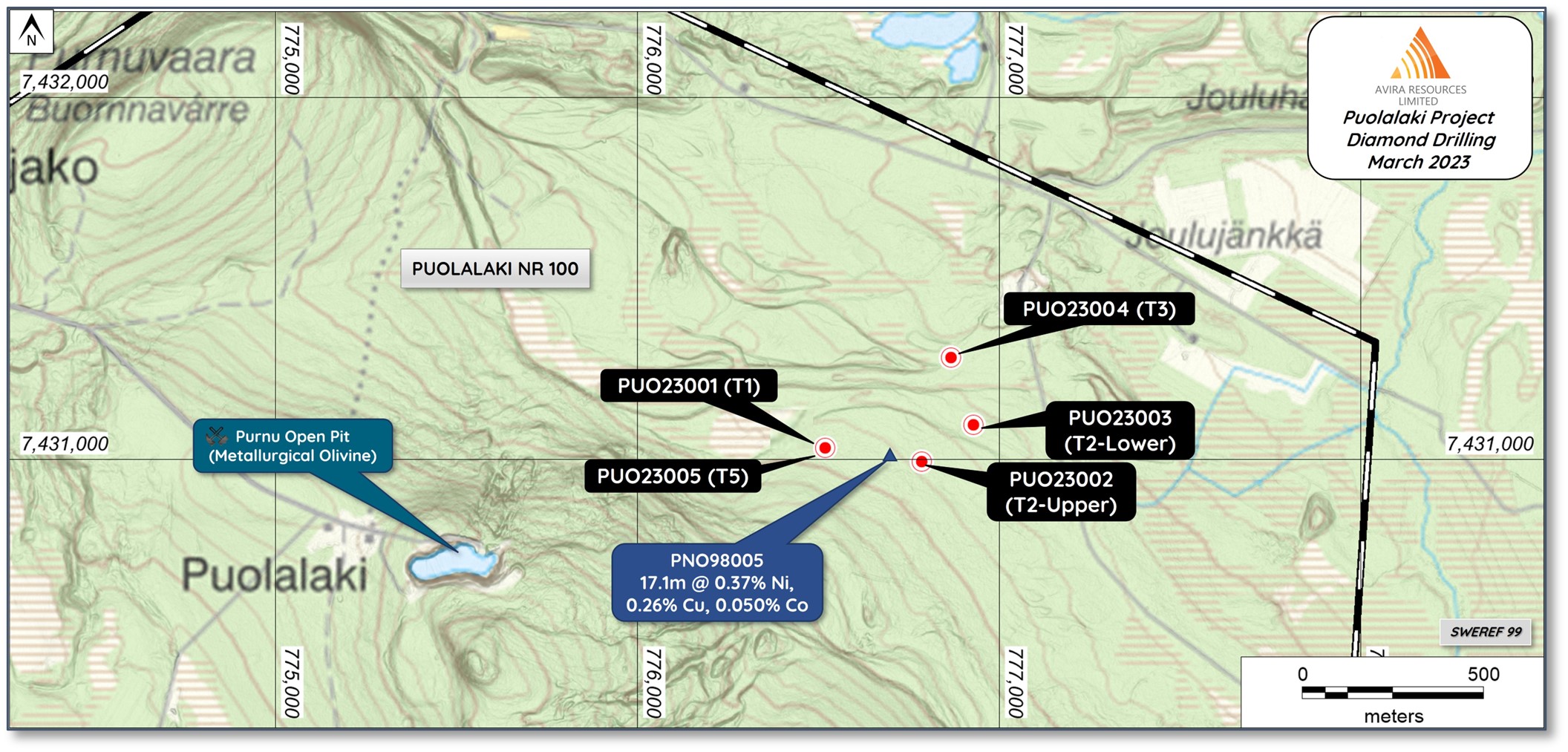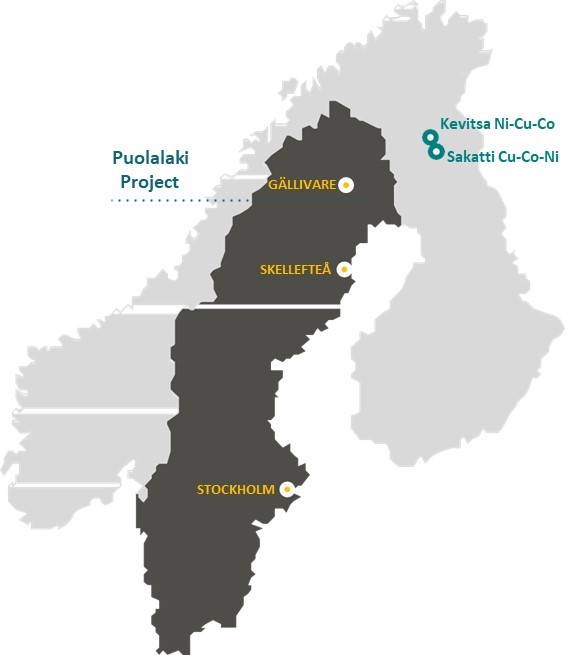OVERVIEW
The Puolalaki Project comprises a single exploration permit (Puolalaki nr 100) cantered over a syn-orogenic gabbro intrusion that hosts the nickel mineralisation discovered by NAN in 1998 . In addition to the Ni-Cu mineralisation at Puolalaki, the project also contains significant, high-grade gold mineralisation across two zones within the metasediments and metavolcanics surrounding the gabbro. The project is located in Sweden’s premier Gällivare mining district which is host to Europe’s largest open- cut copper mine Aitik, owned by Boliden and to LKAB’s Malmberget iron-ore mine.
In 1998, North Atlantic Natural Resources (NAN) drilled two holes intersecting magmatic sulphides at Puolalaki (PNO98004 and PNO98005) that included 24.1m @ 0.22% Ni, 0.28% Cu and 0.035% Co, effectively confirming the occurrence of Ni-Cu-Co mineralisation within the gabbro intrusion. Significant intercepts included:
- PNO98004: 24.1m @ 0.28% Ni, 0.22% Cu, and 0.035% Co from 66.3m
Inc. 10m @ 0.41% Ni, 0.23% Cu and 0.053% Co from 78.3m
- PNO98005: 17.1m @ 0.37% Ni, 0.26% Cu and 0.050% Co from 78.2m
Inc. 6m @ 0.54% Ni, 0.19% Cu and 0.070% Co from 78.2m
Inc. 5.9m @ 0.51% Ni, 0.54% Cu and 0.070% Co from 89.5m
Within a few months of discovering Ni-Cu mineralisation at Puolalaki, NAN discovered Zn-Cu mineralisation at Storliden, near the town of Malå. The Storliden deposit (1.8Mt @ 10.3% Zn, 3.5% Cu) was subsequently mined as a joint venture between NAN and Boliden and no further work was completed at Puolalaki by NAN.
The Ni-Cu mineralisation at Puolalaki has never been followed-up since its discovery in 1998 and consequently provides a fantastic opportunity to carry-out modern, high-powered geophysics over the Puolalaki Project to test the gabbro intrusion for more extensive sulphide mineralisation at depths previously untested (historic geophysics completed at Puolalaki had a penetration depth of approx. 50m).
In 2022, the availability of modern highly-sensitive ground-based electromagnetic (EM) equipment presents an opportunity to test this gabbro intrusion for more extensive sulphide mineralisation, down to a depth of around 400m. Drilling designed from this careful geophysical work might be the discovery holes into the first major Ni-Cu-Co deposit in the Proterozoic rocks of northern Sweden, at time when demand for these metals in Europe could not be higher.
At Puolalaki near Gällivare, a gabbro intrusion with the right mineralogy is emplaced in the right structural and tectonic setting, in an established mining district that includes Boliden’s Aitik Cu-Au mine, and LKAB’s Malmberget iron ore mine.
OPERATIONAL ACTIVITIES
The drilling program consisted of 5 diamond drill holes for a total of 1098.4m targeting magmatic nickel-copper sulphide mineralisation within a gabbroic to ultramafic intrusion. Fixed-loop electromagnetic (FLEM) surveying in February identified 5 conductors that have now been drill tested.
The standout drillhole was PUO23002 testing EM target T2-Upper (refer Figure 3) which was a shallow, complex conductor with a modelled conductance of 40,000S. PUO23002 intercepted disseminated matrix sulphides from the top of bedrock prior to entering a wide zone of massive sulphides from 16.7m downhole to 52.7m downhole. Initial visual logging indicates the sulphide comprises a mix of pyrrhotite and chalcopyrite, with pXRF analyses indicating the presence of nickel, copper and cobalt within pyrrhotite-rich intervals, laboratory assays of sulphide intervals are currently pending.
Hole PUO23002 was ended in disseminated to blebby sulphide mineralisation at 85.7m, after successfully testing the modelled EM conductor.
 Figure 2. Massive sulphide (pyrrhotite-chalcopyrite) from drillhole PUO23002, approx. depth 24.2-26.9m downhole.
Figure 2. Massive sulphide (pyrrhotite-chalcopyrite) from drillhole PUO23002, approx. depth 24.2-26.9m downhole.
The four additional drillholes completed at Puolalaki intercepted zones of either disseminated matrix or blebby to stringer magmatic sulphides at target depths broadly anticipated from modelling of FLEM conductors. These results are not considered sufficient to explain the 10,000S to 20,000S modelled FLEM conductor plates at these targets and DHEM surveys of all 5 holes will be undertaken within the next week further identify additional follow-up drill targets though more defined EM signatures.
Drillhole PUO23003, targeting EM target T2-Lower (refer Figure 3) which appears, from modelling, to sit in a down-dip position from EM target T2-Upper, intercepted disseminated matrix and stringer sulphides although not enough to sufficiently explain the modelled 20,000S FLEM conductor.
Drillhole PUO23005 was drilled to a depth of 602m, targeting a broad and extensive late-time FLEM response (target T5, refer Figure 4) possibly associated with a large conductor (10,000S) at >500m depth. Magmatic sulphide veins and disseminated matrix sulphides intersected at 531-543m are encouraging, but not considered sufficient to explain the FLEM conductor.
Drillhole PUO23002 has been transported to Malå for logging and sampling ahead of assaying and the remaining drillholes will be transported from site to Malå as soon as ground conditions allow. The ALS Global prep lab is located in Malå and expected turn-around-times for assaying are currently two to three weeks from the date of submission at the lab. The Company expects to be in a position to announce the first assay results in May.
Assuming these results are supportive, a second phase of drilling will be planned to commence during the Swedish summer and/or autumn (from June 2023) with these additional drillhole locations based on the results of laboratory assay of core and planned DHEM surveys
Figure 3. Map showing diamond drillhole locations (red dots) and the historic nickel intercept (navy triangle) at the Puolalaki Project, northern Sweden.

 AVW
AVW 